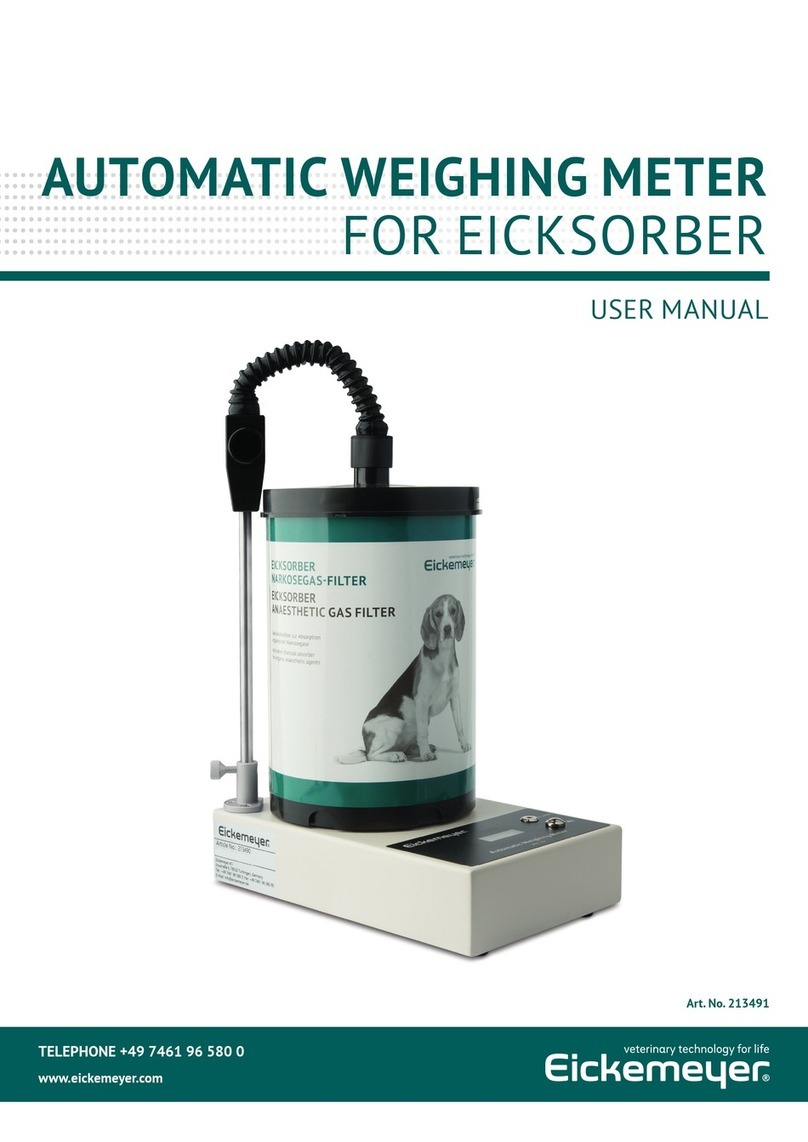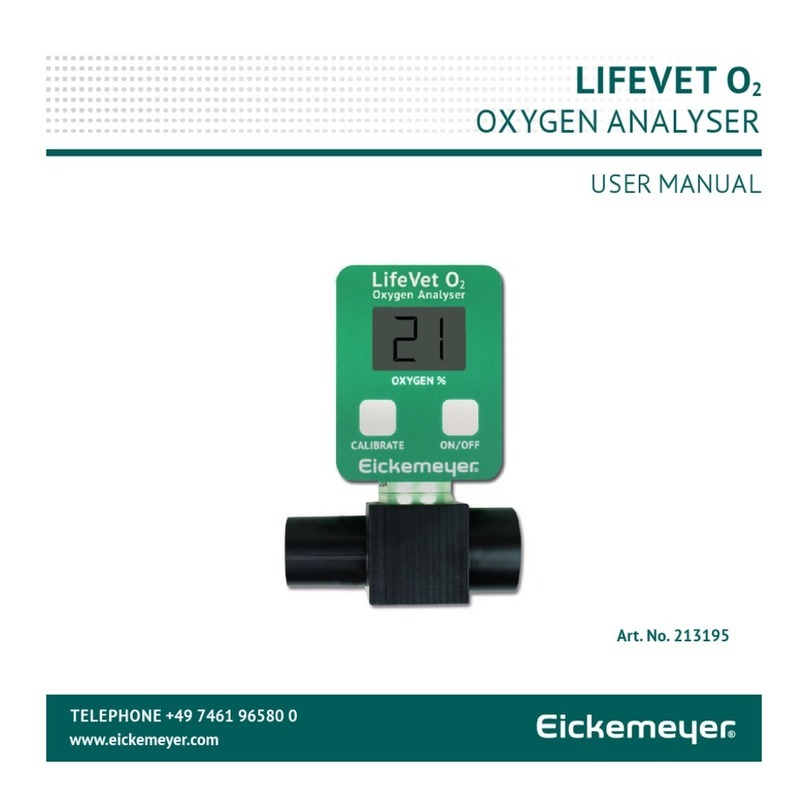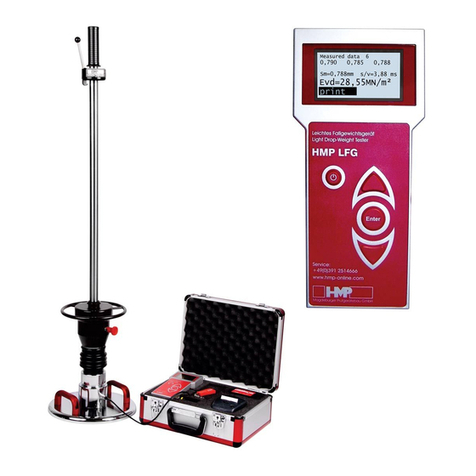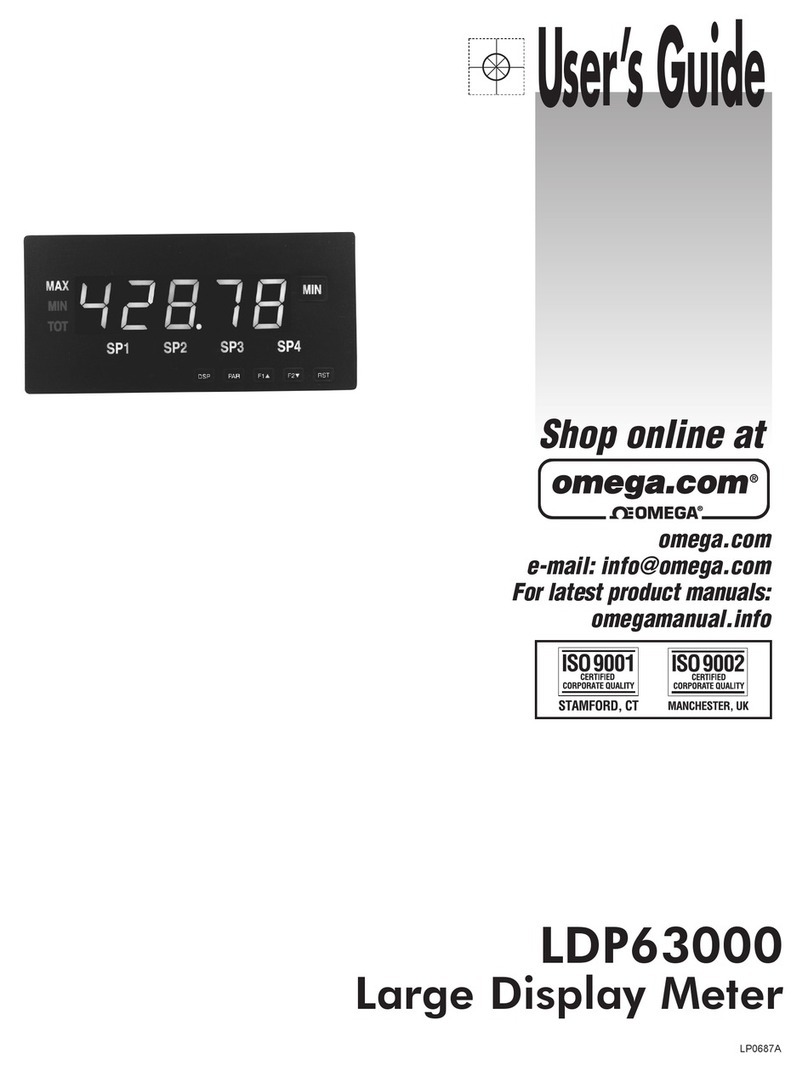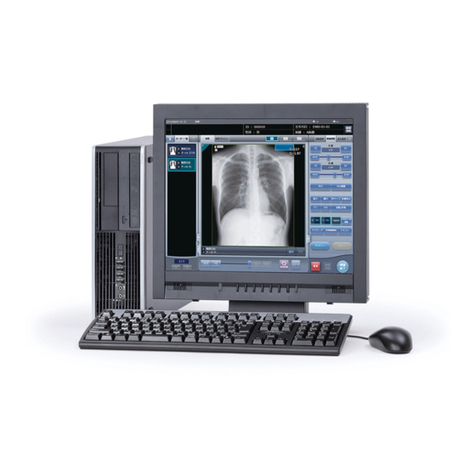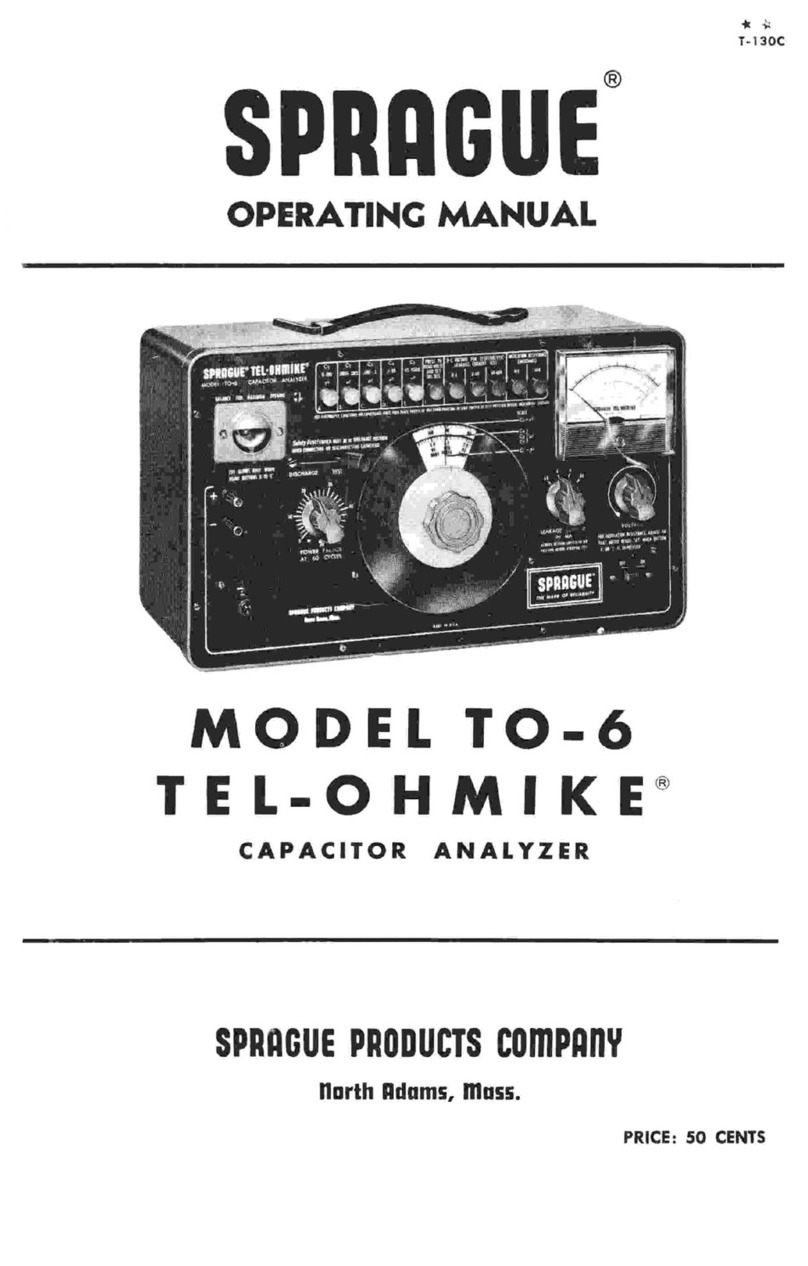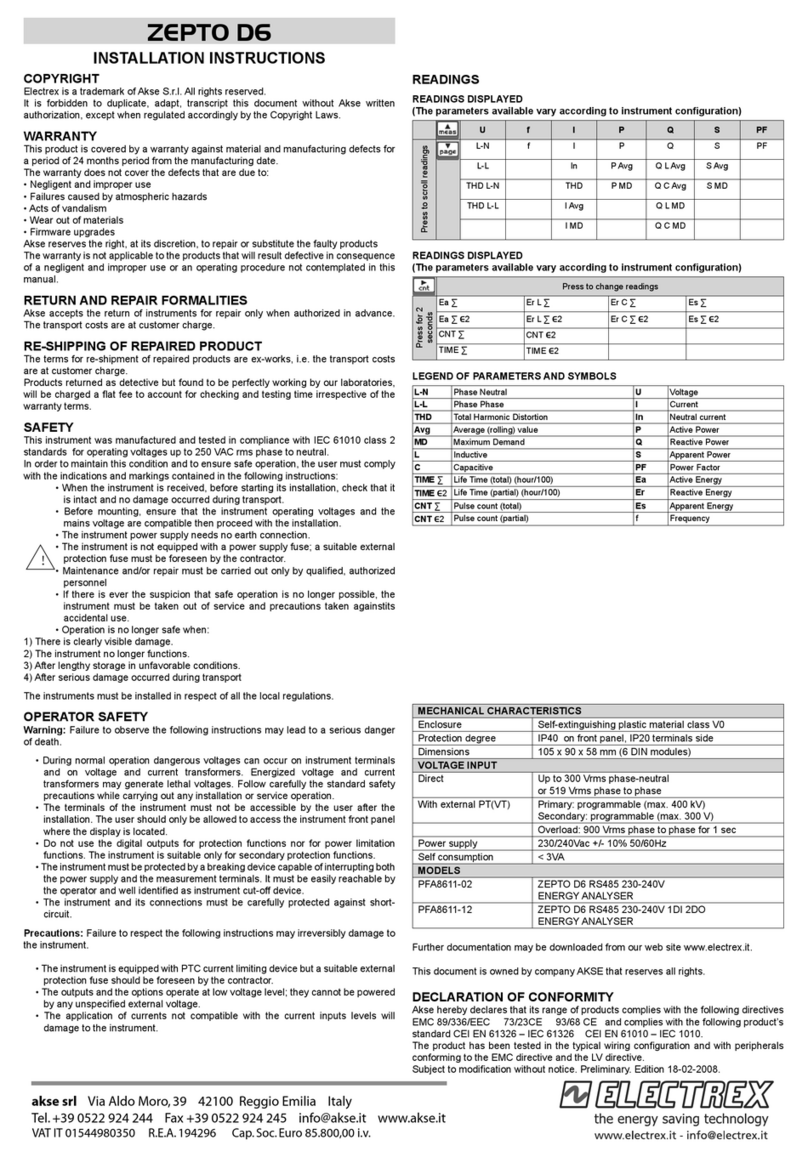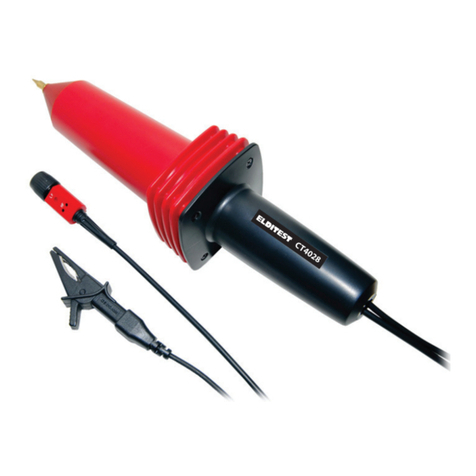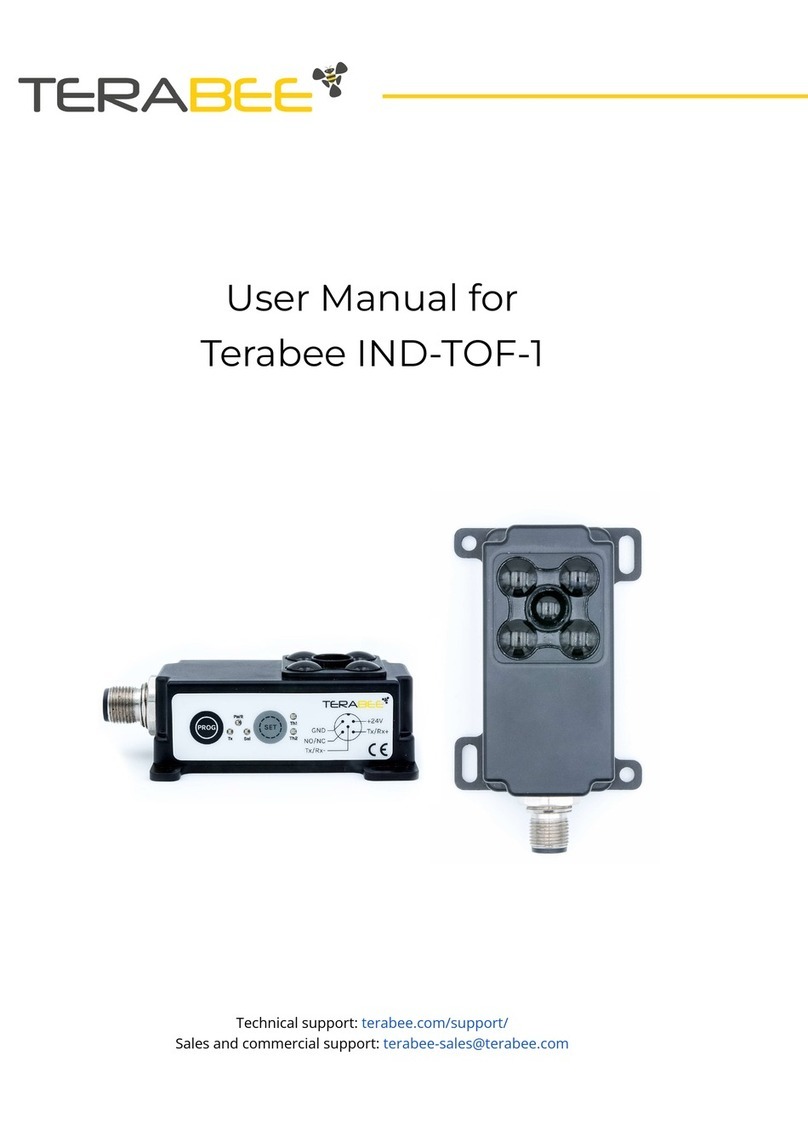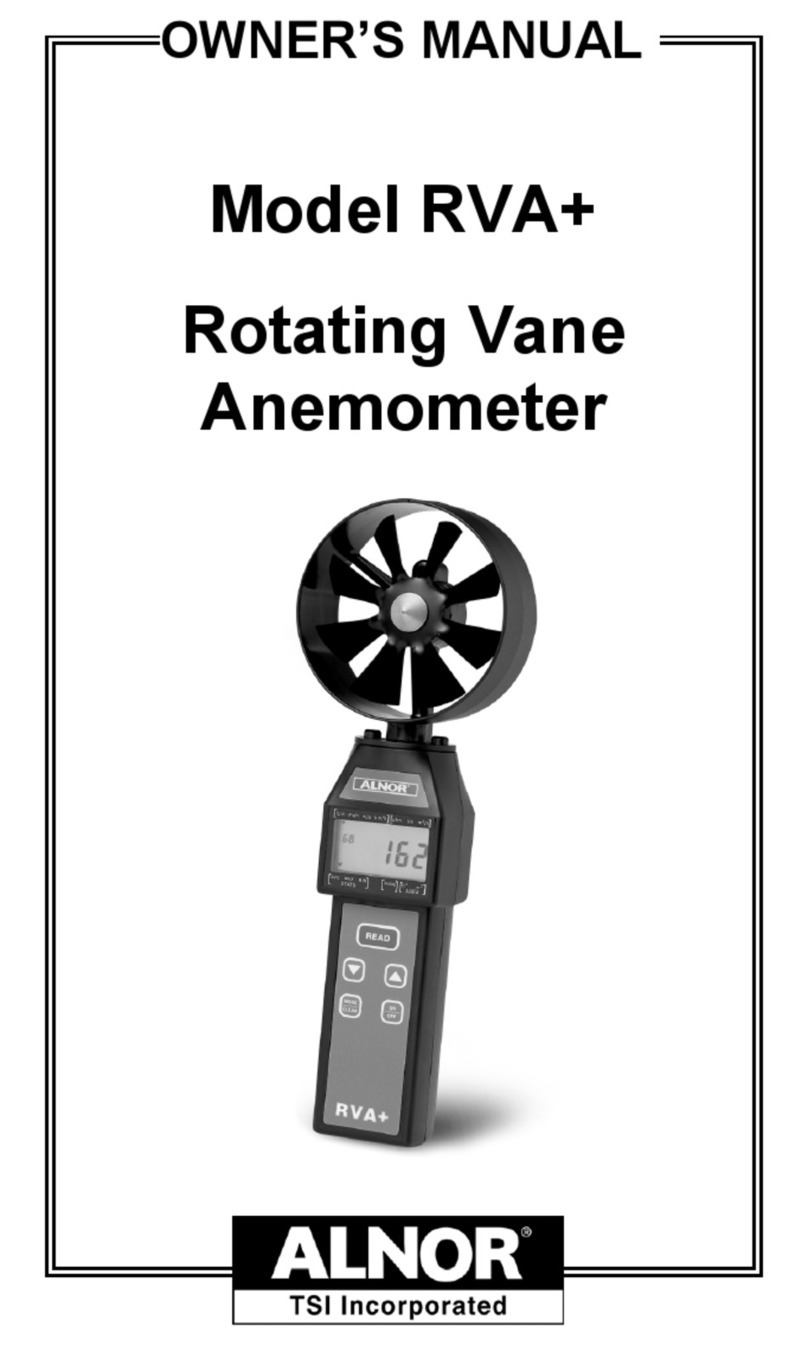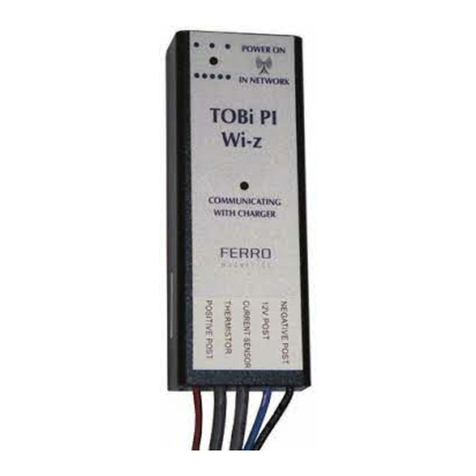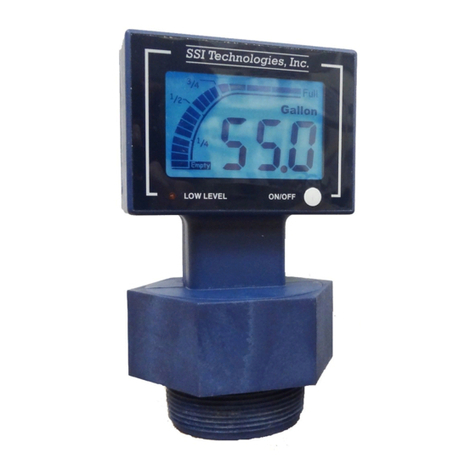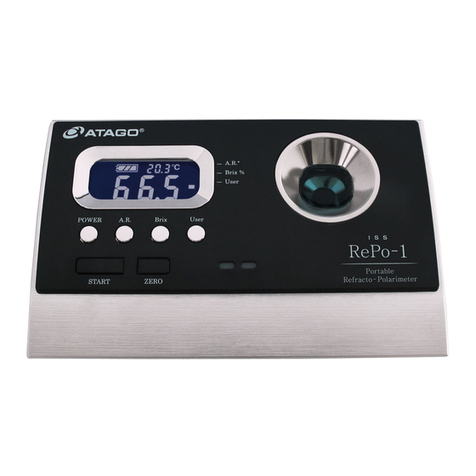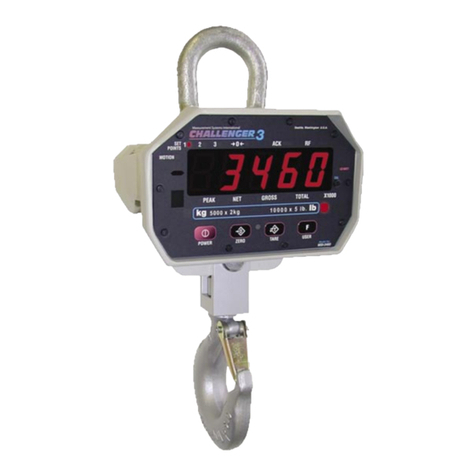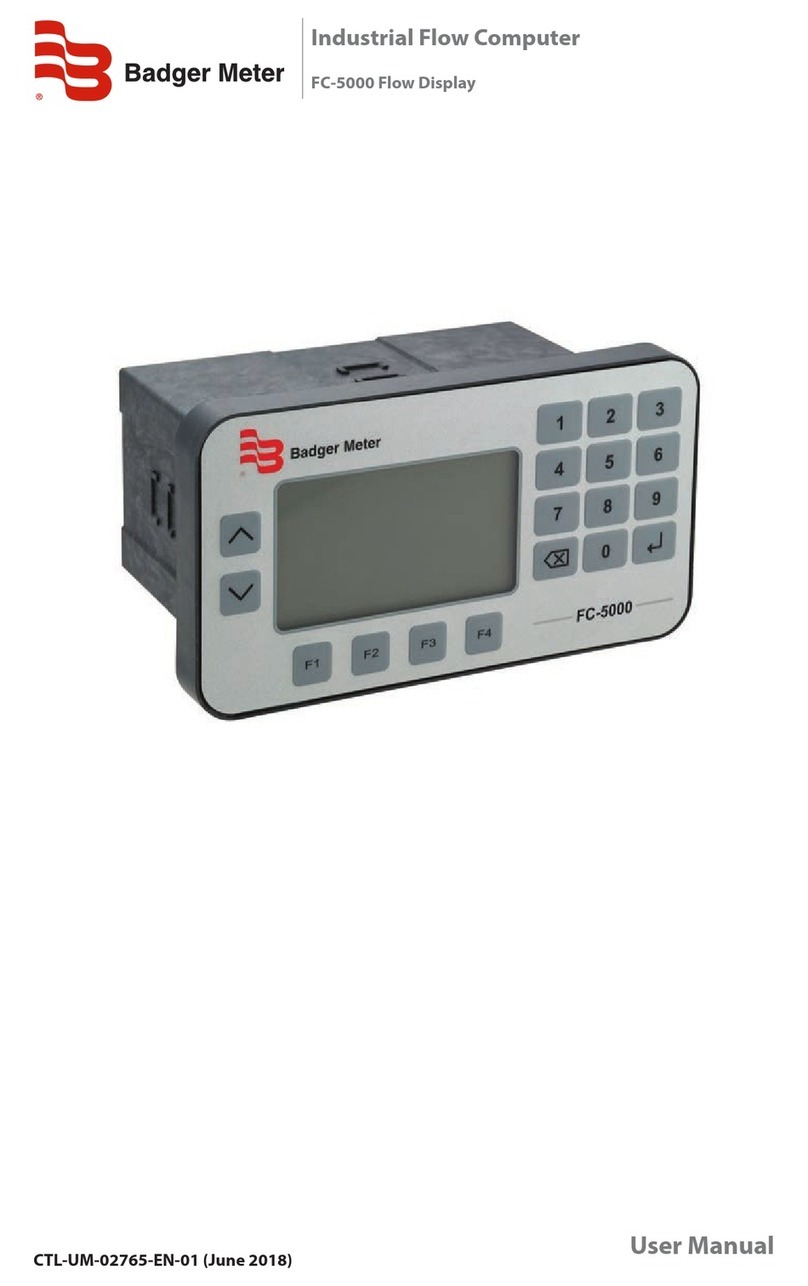Eickemeyer RETEVET PORTABLE ERG User manual

USER MANUAL
TELEPHONE +49 7461 96 580 0
www.eickemeyer.com
Item no. 173610
RETEVET™
PORTABLE ERG

2
USER MANUAL RETEVET™ PORTABLE ERG
T +49 7461 96 580 0 | F +49 7461 96 580 90 | export@eickemeyer.com | www.eickemeyer.com
CONTENT
1. Welcome to RETevet™............................................................................................................. 4
What’s in the Box....................................................................................................................................4
2. Getting Started......................................................................................................................... 5
Connect the Cord to the Docking Station and Plug-in..............................................................5
Let the Device Charge...........................................................................................................................5
Connect the Electrodes ........................................................................................................................5
Device Controls .......................................................................................................................................5
Main Menu................................................................................................................................................6
Settings......................................................................................................................................................6
3. Choosing a Protocol................................................................................................................. 8
Flicker ERG Testing ................................................................................................................................8
Flash ERG Testing ...................................................................................................................................9
Other Protocols .................................................................................................................................... 16
Custom Protocols................................................................................................................................. 16
Reference Intervals............................................................................................................................. 16
4. Before Performing an ERG Test............................................................................................. 17
Anesthesia...............................................................................................................................................17
Monocular or Binocular Recording.................................................................................................17
Preparing the Animal ..........................................................................................................................17
Electrode Choice...................................................................................................................................17
5. Performing an ERG Test .........................................................................................................18
6. Viewing Results......................................................................................................................20
General.................................................................................................................................................... 20
Results on the Device ........................................................................................................................ 20
Results on a PC..................................................................................................................................... 20
Flicker Results on the Device Versus on a PC............................................................................ 26
7. Additional Activities...............................................................................................................28
Removing Old Results from the Device....................................................................................... 28
Removing and Replacing the Eyecup........................................................................................... 28
Updating Firmware............................................................................................................................. 29
8. Troubleshooting Hints...........................................................................................................30
9. References...............................................................................................................................33
10. Regulatory and Safety Information ......................................................................................34
Applicability .......................................................................................................................................... 34
Intended Use......................................................................................................................................... 34
Indications for Use.............................................................................................................................. 34
Latex Statement................................................................................................................................... 34
Specifi cations........................................................................................................................................ 35
Cleaning and Disinfection................................................................................................................ 36
Sterilization ........................................................................................................................................... 36
Biocompatibility................................................................................................................................... 36
Calibration and Storage .....................................................................................................................37
Product Performance...........................................................................................................................37
Essential Performance ........................................................................................................................37
Operating Environment......................................................................................................................37
Lifetime....................................................................................................................................................37
Precautions .............................................................................................................................................37
Electromagnetic Compatibility (EMC) .......................................................................................... 39
RoHS......................................................................................................................................................... 42
China RoHS2 Compliance Statement ........................................................................................... 42
Symbols .................................................................................................................................................. 43
Equipment Identifi cation.................................................................................................................. 44
Approvals................................................................................................................................................ 44

3
USER MANUAL RETEVET™ PORTABLE ERG
T +49 7461 96 580 0 | F +49 7461 96 580 90 | export@eickemeyer.com | www.eickemeyer.com
11. Intellectual Property..............................................................................................................44
12. Contact Information...............................................................................................................45
Support ................................................................................................................................................... 45
Warranty.................................................................................................................................................. 45
Purchasing Supplies and Accessories........................................................................................... 45
Service / Repairs.................................................................................................................................... 46
Copyright © 2012–2019 LKC Technologies, Inc.
LKC Technologies, Inc., established in 1987, is ISO 13485:2016 (MDSAP) certifi ed and an FDA-registered medical device
manufacturer with quality products installed in over fi fty countries.

4
USER MANUAL RETEVET™ PORTABLE ERG
T +49 7461 96 580 0 | F +49 7461 96 580 90 | export@eickemeyer.com | www.eickemeyer.com
1. WELCOME TO RETEVET™
Congratulations on your acquisition of the RETevet™ visual electrodiagnostic device.With the RETevet™ device, you can offer
your patients a convenient retinal diagnostic evaluation. The RETevet™ device is the veterinary version of the RETeval device,
which is a visual electrodiagnostic device approved for use in humans in over 70 countries.
Every RETevet™ device comes with fl icker protocols and single-fl ash protocols for veterinary use. Protocols are available
through a protocol chooser that enables electroretinogram (ERG) testing.
Test results are visible immediately on the device screen. The device automatically creates PDF reports that include test
results, protocol information, patient information and your practice or institution information. These PDF reports can be
transferred to any PC via a USB cable.
What’s in the Box
The RETevet™ device is packaged with these items. Check that all items are present.
RETevet™device Measures the response of the eye to light.
Docking station Charges the RETevet™ device and enables data transfer to a PC.
Dust cover Not shown. Protects the device from dust while not in use.
3-plug electrode lead Connects the device to electrodes for testing.
USB cable Connects the device to a PC to transfer results.
Power brick and plates Connects the device to an electrical outlet. Use the wall-plug option that matches available
electrical outlets.
User Manual This document. The manual is available as a PDF located on the root directory of the
RETevet™ device.
Electrodes Not shown. Depending on what was ordered, electrodes could be ERG Jet electrodes for
large animals, or smaller electrodes sized for rats or mice.Ten needle electrodes as reference
and ground are provided when a primary electrode is ordered.

5
USER MANUAL RETEVET™ PORTABLE ERG
T +49 7461 96 580 0 | F +49 7461 96 580 90 | export@eickemeyer.com | www.eickemeyer.com
2. GETTING STARTED
Connect the Cord to the Docking Station and Plug-in
• Attach the power brick plate that matches your electrical outlet to the power brick.
• Connect the power cord to the docking station.
• Connect the power brick to an electrical outlet. The power supply accepts 100–240 VAC, 50/ 60 Hz.
Let the Device Charge
The RETevet™ device charges its battery when in the docking station from either the USB or power brick connection. If the
power brick is connected, charging will be signifi cantly faster than if only a USB connection is present. The charging status is
shown on the display. If the display is blank, press the power button to turn it on. The RETevet™ device is shipped with a
partial charge.
Connect the Electrodes
Connect the 3-plug electrode lead to the blue lead connector shown in the fi gure above, and then connect the electrodes in
the following way: corneal electrode to the red plug, reference electrode to the black plug and the ground electrode to the
green plug.
Device Controls
The RETevet™ device has an up/ down / right/ left/ select joystick and an on-off power button.
Turning the Device Off
You can turn the device off at any time by pressing the power button.
The screen goes blank immediately, but the device takes a few more seconds to turn off completely.
Wait a few seconds after the power indicator light stops blinking before turning the device back on.

6
USER MANUAL RETEVET™ PORTABLE ERG
T +49 7461 96 580 0 | F +49 7461 96 580 90 | export@eickemeyer.com | www.eickemeyer.com
Joystick
The joystick provides a simple and intuitive user interface. Use your thumb to push the joystick in the desired direction.
UP and DOWN move the selection highlight up or down.
Go back one screen: Press LEFT when the cursor is at the left edge of the screen.
Go forward one screen: Press RIGHT when the cursor is at the right edge of the screen.
Select a highlighted item: Press SELECT.
Main Menu
The RETevet™ device main menu has a top status bar, four buttons and at the bottom a description of the currently-selected
protocol. The status bar shows the time, date, and battery charge state. The four buttons enable the operator to start a new
test, view previous results, change system settings, and choose the protocol that will run when starting a new test. At the
bottom of the screen, the currently selected protocol is displayed.
Settings
Set up the RETevet™ device for use in your practice.
1. Turn on the device.
The device goes through a brief internal test and initialization.
2. Select Settings.
3. Adjust each setting as you prefer.
Language
Use the joystick to scroll through the languages and select the one you want to use for the device’s user interface and PDF
reports.
If you select a right-to-left language (i. e., Arabic), the RIGHT and LEFT joystick directions are swapped from the description
in this manual.

7
USER MANUAL RETEVET™ PORTABLE ERG
T +49 7461 96 580 0 | F +49 7461 96 580 90 | export@eickemeyer.com | www.eickemeyer.com
Date/Time
Use the joystick to select each element of the current date. Use the RIGHT and LEFT joystick directions to move between
pages. The device uses the date and time to label results and to compute the patient’s age.
Backlight
The display backlight can be adjusted to three different levels. Brighter settings may be more visible but will slightly reduce
the number of patients you can test before needing to recharge in the docking station. There is also a “red” option that makes
the display only use red light.For tests requiring dark-adaptation, the display backlight is automatically dimmed and reddened
during the appropriate portion of the protocol.
Practice Information
Practice information is used to label reports. It includes the practice name and three lines for practice address. You can use
these lines for other information if you like. Text is inserted at the blinking vertical cursor. Use the delete key to move to
the left. Practice information is displayed on the report above the patient information as shown in the sample report on
Page22. That sample report has LKC Technologies and its address as the practice information, which is the default for all
devices. Pressing the barcode symbol enables practice information to be scanned from an external display such as a PC
monitor.Scanning is automatic and does not require the joystick to be pressed.Look in the downloads section of https://www.
lkc.com/products/RETevet™ to download the free data entry software. If the RETevet™ device has trouble scanning the
barcode, ensure the eyecup is on or very close to the display, the display brightness is set to maximum, and the mouse cursor
is not superimposed on the barcode.
Page Size
The PDF reports created by the RETevet™ device can be formatted for either A4 sized paper or letter (8.5" x 11") sized paper.
Device Serial Number and Options
To view the device’s serial number and what options are present, select System under Settings.
Under Settings there is also a Report formats menu, where you can select if you want PDF, JPEG, or PNG output formats for
the reports. More than one option can be selected. PDF is the preferred format for printing. JPEG may be more convenient for
uploading results to certain EMR systems.

8
USER MANUAL RETEVET™ PORTABLE ERG
T +49 7461 96 580 0 | F +49 7461 96 580 90 | export@eickemeyer.com | www.eickemeyer.com
3. CHOOSING A PROTOCOL
The RETevet™ device enables you to change the stimulus conditions (called protocols) to best meet your needs via a protocol
chooser. The RETevet™ protocols have fl icker and single fl ash stimuli to provide the complete assessment of the retinal
function.
Flicker ERG Testing
The RETevet™ device supports fl icker ERG testing, as a fast and easy way to assess the functioning of the cone pathways. The
RETevet™ device measures fl icker implicit time quickly and accurately by fl ashing light into the patient’s eye and measuring
the time delay (implicit time) and amplitude of the retina’s electrical response as detected on the eye electrode.
Brief fl ashes of light are provided at the beginning of each 28.3 Hz stimulus period. Background illumination, where present,
uses a pulse-width-modulation (PWM) frequency near 1 kHz. Flicker protocols typically record between 5 and 15 seconds of
data for each stimulus condition stopping after an internal precision metric is reached. Some protocols have multiple stimulus
conditions which are presented sequentially with a short (< 1 s) dark pause between the conditions. A counter on the screen
shows progress for these multi-stimulus protocols.
The RETevet™ device provides fl icker intensities of 3 and 10 cd·s/m² without a background light and the ISCEV standard
3cd·s/m² fl ash with a 30 cd/m² background. If you are unsure which stimulus to use, the ISCEV standard is recommended.
Flicker: 3 cd·s/m²
Description Eye Flash Luminance Energy
(0.33, 0.33 White)
Background Luminance
(0.33, 0.33 White)
# Flashes
Light adapted 3.0 fl icker Right 3 cd·s/m² @ 28.3 Hz Off 141–424
Light adapted 3.0 fl icker Left 3 cd·s/m² @ 28.3 Hz Off 141–424
Flicker: 10 cd·s/m²
Description Eye Flash Luminance Energy
(0.33, 0.33 White)
Background Luminance
(0.33, 0.33 White)
# Flashes
Light adapted 10.0 fl icker Right 10 cd·s/m² @ 28.3 Hz Off 141–424
Light adapted 3.0 fl icker Right 10 cd·s/m² @ 28.3 Hz Off 141–424
Flicker: 3 cd·s/m², 30 cd/m² bg
Description Eye Flash Luminance Energy
(0.33, 0.33 White)
Background Luminance
(0.33, 0.33 White)
# Flashes
Light adapted 10.0 fl icker Right 3 cd·s/m² @ 28.3 Hz 30 cd/m² 141–424
Light adapted 3.0 fl icker Left 3 cd·s/m² @ 28.3 Hz 30 cd/m² 141–424

9
USER MANUAL RETEVET™ PORTABLE ERG
T +49 7461 96 580 0 | F +49 7461 96 580 90 | export@eickemeyer.com | www.eickemeyer.com
Flash ERG Testing
For more complete retinal function testing (including issues of seeing in dim light situations), fl ash testing can be used in
addition to the fl icker testing.
1. Dark-adapted rod response (DA 0.01): provides information about rod system, night vision and therefore is useful in
detecting rhodopsin-related mutations and SARDS for example.
2. Dark-adapted, mixed, rod and cone response (DA 3.0): both, rod and cones are assessed. Photoreceptors are evaluated
separately (a-wave) from their pathways in the inner retina (b-wave) providing generalized yet complete evaluation of the
retinal function.
3. Dark-adapted mixed, rod and cone response to a higher intensity fl ash (DA 10.0): in addition to the information acquired
in the previous step, the response to the higher intensity fl ash allows for the evaluation of the impact the opacity of the
media such as a cataract has on the retinal function.
4. Dark-adapted Oscillatory Potentials (OPs) extracted from the mixed response by using the 85 – 190 Hz bandpass fi lter
provide more subtle and consistent information about the diffused changes in the inner retina caused by e.g., ischemic
events or amacrine cell function.These test results are mainly used for research purposes. Up to 5 cursors are automatically
placed on the oscillatory potential peaks and troughs and are indicated on the report as black dots on the waveform.
Implicit times (time to peak) and amplitudes (peak to following trough) are reported for each individual cursor. The sums
of implicit times and amplitudes for all cursors are also reported. When interpreting the summed cursor times and
amplitudes, you should examine the cursor dots on the waveform to ensure that no waves are missed.
5. Light adapted cone response (LA 3.0) provides an overall assessment of outer and inner retina in the day vision.
6. Light adapted fl icker (LA 3.0 fl icker) is a robust response of the cone pathway and an excellent tool for a quick assessment
of the retinal function.
Flash conditions in those steps depend on the species, particularly on their behavioral time of activity (nocturnal vs. diurnal).
Therefore, protocols are built based on the individual customer’s needs.
Subtests in these protocols display the waveform results after each measurement period and enable the operator to repeat
the step as many times as desired. Automated cursor placements are computed to the average cursor placement across all
repetitions. Any subtest can be skipped without affecting the rest of the protocol. On the review screen, the operator has the
option of selecting which replicates to keep from the reports. This option enables replicates to be deleted in the event, for
example, of poor patient compliance or excess noise in some replicates. To remove a replicate, simply uncheck the box
associated with that replicate. Replicates can be selected or removed anytime while collecting replicates. After you have
moved to the next test step, you no longer can alter the replicate selection for previous steps.
For dark-adapted tests, the display is automatically dimmed and reddened. The green power status LED is also turned off to
assist in dark-adaptation. The display and LED are automatically brightened at the end of the dark-adaptation tests.
To create the visual stimulus, the RETevet™ device generates variable-duration fl ashes of white light, made from red, green,
and blue LEDs all being on for the same duration. The maximum energy fl ash of white light is 30 cd·s/m², which has a fl ash
duration of 5 ms.

10
USER MANUAL RETEVET™ PORTABLE ERG
T +49 7461 96 580 0 | F +49 7461 96 580 90 | export@eickemeyer.com | www.eickemeyer.com
The signal processing for the non-fl icker tests uses the followings steps. A zero-phase 0.3 Hz high-pass fi lter reduces electrode
drift and offset while preserving waveform timing. Measurements from multiple fl ashes are combined to improve the signal
to noise ratio using a trimmed mean to reduce the effect of outliers after removing outlier replicates whose amplitudes
exceed 1 mV. The resulting waveform is then processed using wavelet-based denoising (Ahmadi and Rodrigo 2013) where
wavelets are attenuated based on the signal to noise power between the post-stimulus (signal) and pre-stimulus (noise)
portions of the waveform. Oscillatory potential analysis does not use the wavelet denoising
Ecvo-Based ERG Protocols for Veterinary Use
The RETevet™ device has a series of protocols based on the guidelines for testing dogs (Ekesten et al. 2013). These protocols
all use the acronym ECVO, which stands for European College of Veterinary Ophthalmologists, which were the original basis
for the guidelines.
The protocol ECVO 5-step can be used to assess the functioning of the rod and cone pathways in the retina. Rod function is
assessed with a series of dim fl ashes after a period dark-adaptation (20 minutes is recommended). Next, cone function is
tested after 10 minutes of light adaption. Waiting or examination room ambient light is close to 30 cd/m² which is likely
suffi cient or the built-in 30 cd/m² can be used per each eye. This protocol is recommended for anesthetized or sedated
animals, as the test duration is fairly long.
ECVO 5-step
Description Eye
Flash Luminance Energy
(0.33, 0.33 white)
Background Luminance
(0.33, 0.33 white)
# Flashes
Dark-adaptation timer Both Off Off
Dark-adapted 0.01 Right 0.01 cd·s/m² @ 0.2 Hz Off 4
Dark-adapted 3.0 Right 3 cd·s/m² @ 1 / 15 Hz Off 4
Dark-adapted 10.0 Right 10 cd·s/m² @ 0.05 Hz Off 1
Dark-adapted 0.01 Left 0.01 cd·s/m² @ 0.2 Hz Off 4
Dark-adapted 3.0 Left 3 cd·s/m² @ 1 / 15 Hz Off 4
Dark-adapted 10.0 Left 10 cd·s/m² @ 0.05 Hz Off 1
Light adaptation timer Right Off 30 cd/m²
Light adapted 3.0 Right 3 cd·s/m² @ 2 Hz 30 cd/m² 20
Light adapted 3.0 fl icker Right 3 cd·s/m² @ 28.3 Hz 30 cd/m² 141–424
Light adaptation timer Left Off 30 cd/m²
Light adapted 3.0 Left 3 cd·s/m² @ 2 Hz 30 cd/m² 20
Light adapted 3.0 fl icker Left 3 cd·s/m² @ 28.3 Hz 30 cd/m² 141–424

11
USER MANUAL RETEVET™ PORTABLE ERG
T +49 7461 96 580 0 | F +49 7461 96 580 90 | export@eickemeyer.com | www.eickemeyer.com
Protocol ECVO 5-step single fl ash is a modifi ed version of the ECVO 5-step protocol described above. The difference is while
the ECVO 5-step uses 4 fl ashes in the DA 0.01 and DA 3.0 steps in order to used averaging to improve signal quality, this single
fl ash version only uses 1 fl ash to minimize testing time. Replicates can be made in both protocols, and artefactual results
deleted. This protocol is recommended for NON-anesthetized or NON- sedated animals.
ECVO 5-step single fl ash
Description Eye
Flash Luminance Energy
(0.33, 0.33 white)
Background Luminance
(0.33, 0.33 white)
# Flashes
Dark-adaptation timer Both Off Off
Dark-adapted 0.01 Right 0.01 cd·s/m² @ 0.2 Hz Off 1
Dark-adapted 3.0 Right 3 cd·s/m² @ 1 / 15 Hz Off 1
Dark-adapted 10.0 Right 10 cd·s/m² @ 0.05 Hz Off 1
Dark-adapted 0.01 Left 0.01 cd·s/m² @ 0.2 Hz Off 1
Dark-adapted 3.0 Left 3 cd·s/m² @ 1 / 15 Hz Off 1
Dark-adapted 10.0 Left 10 cd·s/m² @ 0.05 Hz Off 1
Light adaptation timer Right Off 30 cd/m²
Light adapted 3.0 Right 3 cd·s/m² @ 2 Hz 30 cd/m² 20
Light adapted 3.0 fl icker Right 3 cd·s/m² @ 28.3 Hz 30 cd/m² 141 – 424
Light adaptation timer Left Off 30 cd/m²
Light adapted 3.0 Left 3 cd·s/m² @ 2 Hz 30 cd/m² 20
Light adapted 3.0 fl icker Left 3 cd·s/m² @ 28.3 Hz 30 cd/m² 141 – 424
Protocol ECVO short, yes/ no protocol is a modifi ed version of the ECVO 5-step single protocol. Only the dark-adapted steps
are performed. This protocol is recommended for NON-anesthetized or NON-sedated animals when only rod- and mixed rod-
cone retinal function is required to be assessed.
ECVO short, yes /no protocol
Description Eye
Flash Luminance Energy
(0.33, 0.33 white)
Background Luminance
(0.33, 0.33 white)
# Flashes
Dark-adaptation timer Both Off Off
Dark-adapted 0.01 Right 0.01 cd·s/m² @ 0.2 Hz Off 1
Dark-adapted 3.0 Right 3 cd·s/m² @ 1 / 15 Hz Off 1
Dark-adapted 10.0 Right 10 cd·s/m² @ 0.05 Hz Off 1
Dark-adapted 0.01 Left 0.01 cd·s/m² @ 0.2 Hz Off 1
Dark-adapted 3.0 Left 3 cd·s/m² @ 1 / 15 Hz Off 1
Dark-adapted 10.0 Left 10 cd·s/m² @ 0.05 Hz Off 1

12
USER MANUAL RETEVET™ PORTABLE ERG
T +49 7461 96 580 0 | F +49 7461 96 580 90 | export@eickemeyer.com | www.eickemeyer.com
In the protocol Cone function testing, only light-adapted tests are performed. At least 10 minutes exposure to the ambient
light close to 30 cd/m² (outside or examination room) should be done before testing. This protocol is recommended for quick,
cone-based general assessment of the retinal function, for example, for pre-cataract testing. We also recommend this
procedure for the inexperienced users.
Cone function testing
Description Eye Flash Luminance Energy
(0.33, 0.33 White)
Background Luminance
(0.33, 0.33 White)
# Flashes
Light adaptation timer Right Off 30 cd/m²
Light adapted 3.0 Right 3 cd·s/m² @ 2 Hz 30 cd/m² 20
Light adapted 3.0 fl icker Right 3 cd·s/m² @ 28.3 Hz 30 cd/m² 141 – 424
Light adaptation timer Left Off 30 cd/m²
Light adapted 3.0 Left 3 cd·s/m² @ 2 Hz 30 cd/m² 20
Light adapted 3.0 fl icker Left 3 cd·s/m² @ 28.3 Hz 30 cd/m² 141 – 424
In the protocol ECVO long protocol for PRA diagnosis, dim fl ash ERGs are performed during dark adaption in order to assess
the rate of rod recovery in the dark. Measurements occur every 4 minutes starting at time 0. The choice of which eye to test
eye is offered at the beginning of the test, as only one eye is tested. Light adaptation of 10 minutes occurs after the right and
left eyes dark-adapted tests are completed. Waiting or examination room ambient light close to 30 cd/m² is likely suffi cient
or one can use the built-in light-adaptation 10-min period.This protocol is recommended for anesthetized or sedated animals
when the progression of dark-adaptation needs to be evaluated, for example in Progressive Retinal Atrophy (PRA) (Miyadera,
Acland, and Aguirre 2012). PRA is a bilateral disease so that evaluating one eye is suffi cient (Ekesten et al. 2013).
ECVO long protocol for PRA diagnosis
Description Eye Flash Luminance Energy
(0.33, 0.33 White)
Background Luminance
(0.33, 0.33 White)
# Flashes
Dark-adapted 0.01 Operator’s choice 0.01 cd·s/m² @ 0.2 Hz Off 4
Wait remainder of 4 minutes, observe count-down timer, press “Start Test” to continue
Dark-adapted 0.01 0.01 cd·s/m² @ 0.2 Hz Off 4
Wait remainder of 4 minutes, observe count-down timer, press “Start Test” to continue
Dark-adapted 0.01 0.01 cd·s/m² @ 0.2 Hz Off 4
Wait remainder of 4 minutes, observe count-down timer, press “Start Test” to continue
Dark-adapted 0.01 0.01 cd·s/m² @ 0.2 Hz Off 4
Wait remainder of 4 minutes, observe count-down timer, press “Start Test” to continue
Dark-adapted 0.01 0.01 cd·s/m² @ 0.2 Hz Off 4
Wait remainder of 4 minutes, observe count-down timer, press “Start Test” to continue
Dark-adapted 0.01 0.01 cd·s/m² @ 0.2 Hz Off 4
Dark-adapted 3.0 3 cd·s/m² @ 1 / 15 Hz Off 4
Dark-adapted 10.0 10 cd·s/m² @ 0.05 Hz Off 1
Light adaptation timer Off 30 cd/m²
Light adapted 3.0 3 cd·s/m² @ 2 Hz 30 cd/m² 20
Light adapted 3.0 fl icker 3 cd·s/m² @ 28.3 Hz 30 cd/m² 141
– 424

13
USER MANUAL RETEVET™ PORTABLE ERG
T +49 7461 96 580 0 | F +49 7461 96 580 90 | export@eickemeyer.com | www.eickemeyer.com
Protocol ECVO with ERG-measured DA single is a shorted version of ECVO long protocol for PRA diagnosis protocol where the
dark-adapted tests use only 1 fl ash instead of 4. Replicates can be made in both protocols, and artefactual results deleted.
This protocol is recommended for NON-anesthetized or NON-sedated animals.
ECVO long protocol for PRA diagnosis single fl ash
Description Eye Flash Luminance Energy
(0.33, 0.33 White)
Background Luminance
(0.33, 0.33 White)
# Flashes
Dark-adapted 0.01 Operator’s choice 0.01 cd·s/m² @ 0.2 Hz Off 1
Wait remainder of 4 minutes, observe count-down timer, press “Start Test” to continue
Dark-adapted 0.01 0.01 cd·s/m² @ 0.2 Hz Off 1
Wait remainder of 4 minutes, observe count-down timer, press “Start Test” to continue
Dark-adapted 0.01 0.01 cd·s/m² @ 0.2 Hz Off 1
Wait remainder of 4 minutes, observe count-down timer, press “Start Test” to continue
Dark-adapted 0.01 0.01 cd·s/m² @ 0.2 Hz Off 1
Wait remainder of 4 minutes, observe count-down timer, press “Start Test” to continue
Dark-adapted 0.01 0.01 cd·s/m² @ 0.2 Hz Off 1
Wait remainder of 4 minutes, observe count-down timer, press “Start Test” to continue
Dark-adapted 0.01 0.01 cd·s/m² @ 0.2 Hz Off 1
Dark-adapted 3.0 3 cd·s/m² @ 1 / 15 Hz Off 1
Dark-adapted 10.0 10 cd·s/m² @ 0.05 Hz Off 1
Light adaptation timer Off 30 cd/m²
Light adapted 3.0 3 cd·s/m² @ 2 Hz 30 cd/m² 20
Light adapted 3.0 fl icker 3 cd·s/m² @ 28.3 Hz 30 cd/m² 141 –424
PupilLightRefl ex protocol generate 1000 cd/m² red (621 nm) or blue (470 nm) light, as selected by the operator so the pupil
responses can be observed on the display and noted down. No report is generated. This protocol should not be used if the
animal has been artifi cially dilated, as the pupils will be unresponsive.
Iscev-Based ERG Protocols for Animal Use
These protocols are created for research and pharmaceutical testing.They use standards published for humans by International
Society for Clinical Electrophysiology of Vision (ISCEV) and are most suitable for basic discovery, pre-clinical, and toxicology
studies.
The following tables describe other ERG protocols for animal use.
In the protocol Dog, Cat, Nonhuman Primate 6 step, light adapted fi rst, light adapted tests are performed fi rst. The 10-min
light adaptation in the waiting or examination room ambient light is often considered suffi cient. A minimum dark-adaptation
period of 20 minutes is suggested to measure rod function.
Oscillatory potentials, the 6th step in the protocol, are automatically extracted and measured from the dark-adapted 3.0 test.

14
USER MANUAL RETEVET™ PORTABLE ERG
T +49 7461 96 580 0 | F +49 7461 96 580 90 | export@eickemeyer.com | www.eickemeyer.com
Dog, Cat, Nonhuman Primate, 6-step, light adapted fi rst
Description Eye Flash Luminance Energy
(0.33, 0.33 White)
Background Luminance
(0.33, 0.33 White)
# Flashes
Light adapted 3.0 Right 3 cd·s/m² @ 2 Hz 30 cd/m² 20
Light adapted 3.0 fl icker Right 3 cd·s/m² @ 28.3 Hz 30 cd/m² 141 – 424
Light adapted 3.0 Left 3 cd·s/m² @ 2 Hz 30 cd/m² 20
Light adapted 3.0 fl icker Left 3 cd·s/m² @ 28.3 Hz 30 cd/m² 141 – 424
Dark-adaptation timer Both Off Off
Dark-adapted 0.01 Right 0.01 cd·s/m² @ 0.5 Hz Off 3
Dark-adapted 3.0 Right 3 cd·s/m² @ 0.1 Hz Off 3
Dark-adapted 10.0 Right 10 cd·s/m² @ 0.05 Hz Off 3
Dark-adapted 0.01 Left 0.01 cd·s/m² @ 0.5 Hz Off 3
Dark-adapted 3.0 Left 3 cd·s/m² @ 0.1 Hz Off 3
Dark-adapted 10.0 Left 10 cd·s/m² @ 0.05 Hz Off 3
Alternatively, the dark-adapted steps can be performed fi rst, as done in the Dog, Cat, Nonhuman Primate, 6-step, dark-adapted
fi rst protocol.
Dog, Cat, Nonhuman Primate, 6- step, dark-adapted fi rst
Description Eye Flash Luminance Energy
(0.33, 0.33 White)
Background Luminance
(0.33, 0.33 White)
# Flashes
Dark-adaptation timer Both Off Off
Dark-adapted 0.01 Right 0.01 cd·s/m² @ 0.5 Hz Off 3
Dark-adapted 3.0 Right 3 cd·s/m² @ 0.1 Hz Off 3
Dark-adapted 10.0 Right 10 cd·s/m² @ 0.05 Hz Off 3
Dark-adapted 0.01 Left 0.01 cd·s/m² @ 0.5 Hz Off 3
Dark-adapted 3.0 Left 3 cd·s/m² @ 0.1 Hz Off 3
Dark-adapted 10.0 Left 10 cd·s/m² @ 0.05 Hz Off 3
Light adaptation timer Right Off 30 cd/m²
Light adapted 3.0 Right 3 cd·s/m² @ 2 Hz 30 cd/m² 20
Light adapted 3.0 fl icker Right 3 cd·s/m² @ 28.3 Hz 30 cd/m² 141 – 424
Light adaptation timer Left Off 30 cd/m²
Light adapted 3.0 Left 3 cd·s/m² @ 2 Hz 30 cd/m² 20
Light adapted 3.0 fl icker Left 3 cd·s/m² @ 28.3 Hz 30 cd/m² 141 – 424
For testing rabbits and mini-pigs, Rabbit,mini pig, photopic 2 step and Rabbit, mini pig, scotopic 4 step were designed (McGee,
Dembinska, and Gruebbel 2005). Photopic and scotopic tests can be performed separately or together depending on the study
design.

15
USER MANUAL RETEVET™ PORTABLE ERG
T +49 7461 96 580 0 | F +49 7461 96 580 90 | export@eickemeyer.com | www.eickemeyer.com
Rabbit, mini pig, photopic 2 step
Description Eye Flash Luminance Energy
(0.33, 0.33 White)
Background Luminance
(0.33, 0.33 White)
# Flashes
Light adapted 8.0 Right 8 cd·s/m² @ 2 Hz 30 cd/m² 20
Light adapted 8.0 fl icker Right 8 cd·s/m² @ 28.3 Hz 30 cd/m² 141 – 424
Light adapted 8.0 Left 8 cd·s/m² @ 2 Hz 30 cd/m² 20
Light adapted 8.0 fl icker Left 8 cd·s/m² @ 28.3 Hz 30 cd/m² 141 – 424
For the dark-adapted testing, dark adaption can be done overnight before the test starts or for at least 20 minutes before
testing. Use the red backlight option in Settings (see page 6) to start the test with a red screen. Oscillatory potentials are
automatically calculated from the DA 8.0 test, which is the 4th step in the protocol.
Rabbit, mini pig, scotopic 4 step
Description Eye Flash Luminance Energy
(0.33, 0.33 White)
Background Luminance
(0.33, 0.33 White)
# Flashes
Dark-adapted 0.6 Right 0.06 cd·s/m² @ 0.5 Hz Off 3
Dark-adapted 8.0 Right 8 cd·s/m² @ 0.1 Hz Off 3
Dark-adapted 25 Right 25 cd·s/m² @ 0.05 Hz Off 3
Dark-adapted 0.06 Left 0.06 cd·s/m² @ 0.5 Hz Off 3
Dark-adapted 8 Left 8 cd·s/m² @ 0.1 Hz Off 3
Dark-adapted 25 Left 25 cd·s/m² @ 0.05 Hz Off 3
For testing rats and mice, dimmer stimuli are typically used (Dembinska et al. 2001, Dembinska et al. 2002, Polosa et al. 2019).
Photopic and scotopic tests can be performed separately or together depending on the study design, there are separate
protocols for measuring just the animal’s right or left eye.
Rat, mouse photopic 2 step left eye
Description Eye Flash Luminance Energy
(0.33, 0.33 White)
Background Luminance
(0.33, 0.33 White)
# Flashes
Light adapted 8.0 Left 8.0 cd·s/m² @ 2 Hz 30 cd/m² 20
Light adapted 8.0 fl icker Left 8.0 cd·s/m² @ 28.3 Hz 30 cd/m² 141 – 424
Rat, mouse photopic 2 step right eye
Description Eye Flash Luminance Energy
(0.33, 0.33 White)
Background Luminance
(0.33, 0.33 White)
# Flashes
Light adapted 8.0 Right 8.0 cd·s/m² @ 2 Hz 30 cd/m² 20
Light adapted 8.0 fl icker Right 8.0 cd·s/m² @ 28.3 Hz 30 cd/m² 141 – 424
Overnight dark-adaptation is recommended in rodents. Oscillatory potentials are automatically calculated from the DA 8.0
test, which is the 3rd step in the protocol.

16
USER MANUAL RETEVET™ PORTABLE ERG
T +49 7461 96 580 0 | F +49 7461 96 580 90 | export@eickemeyer.com | www.eickemeyer.com
Rat, mouse scotopic 3 step left eye
Description Eye Flash Luminance Energy
(0.33, 0.33 White)
Background Luminance
(0.33, 0.33 White)
# Flashes
Dark-adapted 0.002 Right 0.002 cd·s/m² @ 0.5 Hz Off 3
Dark-adapted 8.0 Right 8.0 cd·s/m² @ 0.1 Hz Off 1
Rat, mouse scotopic 3 step right eye
Description Eye Flash Luminance Energy
(0.33, 0.33 White)
Background Luminance
(0.33, 0.33 White)
# Flashes
Dark-adapted 0.002 Left 0.002 cd·s/m² @ 0.5 Hz Off 3
Dark-adapted 8.0 Left 8.0 cd·s/m² @ 0.1 Hz Off 1
Other Protocols
The RETevet™ device has two protocols for which measurements are not obtained: The other two protocols are “fl ashlight”
protocols where the device creates either 30 cd/m² or 300 cd/m² white light.
Custom Protocols
If there is a protocol that you would like to run that is not built in the RETevet™ device, a custom protocol can be created for
you. Contact EICKEMEYER® for more information on how to obtain and use a custom protocol. Typically, custom protocols
should defi ne, which tests will be run and what will be the conditions of those tests such as the stimuli intensity, frequency,
color, duration, and type (on-off, ramp, or sinusoidal stimuli).
Custom protocols must be transferred in the Protocols folder on the device. The built-in protocols can be viewed on the device
in the folder EMR/ Built-in protocols, which can be a starting point for creating your own custom protocols. Protocols are
written in the full-featured Lua programming language.
Reference Intervals
The RETevet™ device has built-in infrastructure to handle and report your reference interval data. We doe not provide non-
human reference data, as there are dependencies on species, breed, and electrode type used. However, if in your practice you
have tested many subjects with normal vision, contact EICKEMEYER® support for assistance in incorporating your own
reference data.

17
USER MANUAL RETEVET™ PORTABLE ERG
T +49 7461 96 580 0 | F +49 7461 96 580 90 | export@eickemeyer.com | www.eickemeyer.com
4. BEFORE PERFORMING AN ERG TEST
Anesthesia
An ERG can be obtained without anesthesia or sedation in dogs. In other animals, anesthesia may be needed in order to
complete the test. Anesthesia usually will affect the ERG, and the literature should be consulted for recommendations. Make
sure the eyes of anesthetized animal will not roll down,which may occur with certain pharmacological agents or by a physical
block.Typically,for research purposes animals (mice,rats,rabbits,dogs,pigs,NHP) can be anesthetized with a Ketamine/Xalazine
combination for ERG recordings. Tenneson and Vezina studied 6 different anesthetic agents in a 2017 ARVO poster, a copy of
which is https://www.criver.com/sites/default/fi les/resource-fi les/SP-ARVO-17-effect-of- anesthetic-selection-for-ERG.pdf.
Monocular or Binocular Recording
Consider whether you would like to obtain an electroretinogram from one eye (monocular) or from both eyes (binocular).
Monocular recording is faster, and may be suffi cient when there is a strong possibility that the eyes are similar, for example:
in systemic exposure models in rats and mice in research or in toxicology safety evaluations in rabbits. With monocular
interventions, recording from both eyes enable the untreated eye to be a control if binocular recordings are made.
Preparing the Animal
Preform ERG testing before photography or indirect ophthalmoscopy if dark-adapted recordings are desired, because
60minutes are needed for the rods to fully recover from bright light exposures (Tuntivanich et al. 2005).
Dilate the pupils using, for example, a combination of 0.5 % proparacaine and 1 % of tropicamide. Wait 20–30 minutes for
full dilation. Cautiously verify dilation, especially in black-eyed animals. Anesthetize the cornea around 5 minutes prior to the
recording.
Use goniosol or other methylcellulose solution to provide a conductive path between a contact lens electrode and the cornea.
If needed, plan ahead for the location and how the animal will be dark-adapted. Use dim red lights in the dark room because
rods are insensitive to red light.
Ensure normal body temperature is maintained if the animal is anesthetized. Electroretinograms are temperature-
dependent.
Make sure you have all the electrodes and eye speculum if needed.
Electrode Choice
Choose the electrode based on the size of the animal to be tested. ERG-Jet and DTL electrodes are common in larger animals
(Mentzer et al. 2005) as well as the newer RM-canine electrode. For smaller animals such as mice and rats, DTL or contact lens
electrodes can be used. All these electrodes are available from EICKEMEYER®. While individual preferences vary, we
recommend ERG-Jet or RM-canine electrodes for the larger animals. Stainless-steel needle electrodes are used as reference
and ground electrodes and they are also available from EICKEMEYER®.

18
USER MANUAL RETEVET™ PORTABLE ERG
T +49 7461 96 580 0 | F +49 7461 96 580 90 | export@eickemeyer.com | www.eickemeyer.com
5. PERFORMING AN ERG TEST
1. Remove the RETevet™ device from the docking station.
2. Confi rm the protocol is the one desired by looking at the protocol title at the bottom of the screen. If not, select Protocol
on the device and change it to the desired protocol. See manual section Choosing a protocol on page 8.
3. Select New Test on the device.
4. Enter patient information as prompted by the device (name or identifi er and date of birth). Pressing the barcode symbol
enables patient information to be scanned from an external display such as a PC monitor. Scanning is automatic and
does not require the joystick to be pressed. Look in the downloads section of https://www.lkc.com/products/RETevet™ to
download the free data entry software. If the RETevet™ device has trouble scanning the barcode, ensure the eyecup is on
or very close to the display, the display brightness is set to maximum, and the cursor is not superimposed on the barcode.
5. Confi rm that the protocol and patient information are correct.
6. Make sure animal has dilated pupils and anesthetized corneas.
7. Place electrodes for the right eye.
A Proper placement for un-anesthetized pets and larger, anesthetized experimental animals is shown in fi gure A: active
ERG-Jet electrode on the cornea, reference electrode 1–2 cm from the tested lateral canthus in veterinary clinic or at
the base of the ear in research or pharmaceutical testing, and ground electrode on the top of the head or between the
shoulder blades. Place the electrodes in the following order: ground, reference,active electrode. If the ERG-Jet electrode
is used fi ll half of it just before positioning it on the cornea. An eye retractor (speculum) can be used or the eye must be
kept open by the operator. For dark-adapted tests, collect the ERGs from the right eye while the left eye is covered.
Remember: the reference electrode must be placed on the tested side: 1–2 cm from the right lateral canthus or at the base
of the right ear when the right eye is tested and 1–2 cm from the left lateral canthus or at the base of the left ear when the
left eye is tested. Other places such as cheek or mouth can be used to place the reference electrode. Keep it consistent
throughout all your tests. Consider using the Mounting Arm instead of holding RETevet™ with anesthetized animal.
B Proper placement of the electrodes for small, anesthetized, experimental animals is shown in fi gure B: active jet (loop
or DTL) electrode on the cornea, reference electrode at the base of the ear on the tested side, or in the mouth and
ground electrode in the tail.
If the electrical connection is noisy, the RETevet™ device will warn you of the poor connection so that it can be
improved before proceeding. Make sure the Jet electrode is adhering to the cornea, add goniosol solution (or similar),
replace the electrode(s) or see the Troubleshooting section of this manual for suggestions on how to resolve the issue.
A

19
USER MANUAL RETEVET™ PORTABLE ERG
T +49 7461 96 580 0 | F +49 7461 96 580 90 | export@eickemeyer.com | www.eickemeyer.com
B
8. Test the right eye.
Select Next.
Position the device so that the animal’s pupil is inside the large green circle and the RETevet™ device is as close as
possible and not interfering with the electrodes Remove the eye cup if needed.
Select Start Test to start the test after the pupil has been placed in the green circle. At the beginning of each test, the
RETevet™ device automatically recalibrates the light intensity and color. This process takes about one second. Wait while the
device conducts the ERGs. Testing time depends on the protocol that you have selected and can be less than 10 seconds or
as long as a couple of minutes. Cover the left eye if dark-adapted ERGs are recorded.

20
USER MANUAL RETEVET™ PORTABLE ERG
T +49 7461 96 580 0 | F +49 7461 96 580 90 | export@eickemeyer.com | www.eickemeyer.com
9. Test the left eye
After the device has indicated that the testing is complete for the right eye, switch active and reference electrodes to the
left eye. Ground electrode stays at the same position in the back. Repeat Step 6 for the left eye. There is no need to cover
the already tested right eye.
Remove the electrodes while the device is saving the results. A Next button appears along with a notifi cation of successful
storage upon completion of the save, which can take several seconds.
If any of the steps could not be completed as described above, and error messages are displayed see the Troubleshooting
section of this manual to resolve those problems.
Clean the eyecup and other animal-contact parts of the device.
6. VIEWING RESULTS
General
Results are shown on the RETevet™ device and are ready to print on a PC when the ERG tests are completed successfully.The
ISCEV standard states that each laboratory should establish or confi rm typical reference values for its own equipment,
recording protocols, and patient populations. When referring to the literature for clinical interpretation, it is important to
verify the material and methods before drawing conclusions.
Viewing the results on the device is used to quickly assess the results and decide upon the next steps without printing the
results.
Examining the results on a PC, displayed as a ready-to-print pdf fi le, allows for more detailed data analysis, printing, archiving
and fi le sharing after the patient examination.
Results on the Device
Results Summary is displayed on the screen at the end of the test as pictured below. Results details are also visible from the
main menu Results option. Scroll up and down through the list and select the desired test result. The results are stored in
chronological order; with the most recent result fi rst. By pressing “More” button, waveform, testing condition, implicit times,
and amplitudes for each eye can be seen.
Results on a PC
Results can be transferred to the PC in PDF format.
1. Place the RETevet™ device into the docking station.
2. Connect the USB cable to the docking station and to the PC.
3. The device appears on the PC like a thumb drive or external USB drive.
You can now view results or copy them to the PC as you would see fi les in any directory on the PC. If the RETevet™ device
does not connect as a USB drive (called RETeval) on your PC, see the Troubleshooting section below.
This manual suits for next models
1
Table of contents
Other Eickemeyer Measuring Instrument manuals

